Ars sacra
ANA KAPOR, A SERBIAN PAINTER FROM ROME, IN A QUEST FOR THE MAGIC OF THE URBAN
City as an art and miracle
Ana builds on the great tradition of Italian maestros enchanted with architecture, those who searched through edifices and ruins like through archives, perceiving the urban as a kind of grandiose history and repository of centuries. However, her approach and poetics makes her, in this respect, unequaled in the recent arts. She is not concerned with the phenomenal, but with ideational aspects of the urban, she is not exploring types and perspectives, but city as an archetype, symbol and secret. For this reason, her paintings do not feature webs of alleys, boats in a harbor, street vendors, atmosphere of evanescence and traces of humanity. She is a painter of the ideal, eternal, celestial city, fortress of God, a trap for the soul described by Saint Teresa of Ávila and Leonid Seika.
By: Dejan Đorić
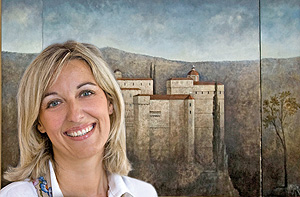 Every exhibition of Ana Kapor attracts great interest of general and professional public. Her solo painting exhibition held at ULUS Gallery in Belgrade this fall, brought the visitors back to art gallery from where they had long been ousted by the force of current ”avant-garde explorations”. Only in one hour the number of visitors was higher than for entire duration of some other exhibitions. What attracted such attention of Belgrade people? Every exhibition of Ana Kapor attracts great interest of general and professional public. Her solo painting exhibition held at ULUS Gallery in Belgrade this fall, brought the visitors back to art gallery from where they had long been ousted by the force of current ”avant-garde explorations”. Only in one hour the number of visitors was higher than for entire duration of some other exhibitions. What attracted such attention of Belgrade people?
Ana Kapor (Belgrade, 1964) comes from the family of writers, painters and musicians, and her husband Vladimir Pajević is one of the best Serbian and European figure painters. For twenty five years she has been living and working in Rome, where she graduated from the Academy of Fine Arts in 1987. After twelve-year long break, she exhibited her thirty new paintings in Belgrade and delivered quite a lecture to local artists.
The extent in which Ana Kapor's presentation is based on the highest artistic and ideational level is proved by her numerous exhibitions and exceptional catalogues. Organized in major Italian cities, these exhibitions were typically covered by the leading art critics and foreword writers. International success is also the crown of her artwork thus far.
The Belgrade exhibition was a retrospective one, an overview of her artwork in the last five years, and after Belgrade the entire exhibition was moved to several major Italian galleries.
SALVAGING THE SACRAL GARDEN
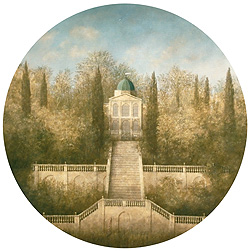 What is it that makes this artist so exceptional, to the point that her biography, in the time of decline (more precisely, violent repression) of old mediums, looks more like the biography of a successful contemporary avant-garde artist than that of an artistic nun who, in the solitude of her studio, patiently and carefully makes her oil paintings? What is it that makes this artist so exceptional, to the point that her biography, in the time of decline (more precisely, violent repression) of old mediums, looks more like the biography of a successful contemporary avant-garde artist than that of an artistic nun who, in the solitude of her studio, patiently and carefully makes her oil paintings?
It must be said immediately that she has found the magic formula, propitious both for her and for painting in general. She has managed to transform, in her artwork, the world of typically Italian tradition, the world of beautiful villas, palaces, churches, towers, bridges, powerful fortifications, into an architecturally model esthetics. Just like being maestros in modeling shoes, parquet, automobiles or speakers, the Italians – from Vitruvio, Brunelleschi, Bramante, Michelangelo, Palladio, Bernini, Borromini to Saint Elias and Paulo Portuguese – were also modeling cities. They saw city as a stage, theatre, a kind of total work of art (Gesamtkunstwerk), theatre for small and selected audience, which is abundant in colors, details, shapes and factures. Italy revealed architecture to Europe as intimate, and Ana Kapor embodied this charm in the form of painting. Like any theatre, and in Italy even the landscape is changed as to provide the desired appearance, her paintings of old buildings have certain magical quality.
 She is maybe the last disciple of the school of Italian maestros enchanted with architecture, painters and graphic artists such as Canaletto, Bellotto, Francesco Guardi, Piranesi or Giorgio de Chirico. Many of them were concerned with urban topography, they described various human habitats, influencing generations of European painters to dedicate themselves to Venice, Rome or Campagna. Long ago, it was Nicolas Poussin who historized the location, searched trough edifices and ruins like through archives, which was a great inspiration, and not only a romanticist one. The urban isa kind of grandiose history and repository of centuries. She is maybe the last disciple of the school of Italian maestros enchanted with architecture, painters and graphic artists such as Canaletto, Bellotto, Francesco Guardi, Piranesi or Giorgio de Chirico. Many of them were concerned with urban topography, they described various human habitats, influencing generations of European painters to dedicate themselves to Venice, Rome or Campagna. Long ago, it was Nicolas Poussin who historized the location, searched trough edifices and ruins like through archives, which was a great inspiration, and not only a romanticist one. The urban isa kind of grandiose history and repository of centuries.
There are also very different approaches to the poetics of landscape and architecture, and in this Ana Kapor is unequaled in the contemporary arts. A small number of artists turned to the specificity in the Italian vision of the relationship between nature, building and human. A few of them understood that they should not be concerned with the phenomenal, but with ideational aspects of the urban, that they should not explore types of representation and types of perspective, but city as an archetype, symbol and secret. For this reason, her paintings do not feature webs of alleys, boats in a harbor, street vendors, atmosphere of evanescen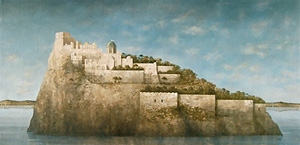 ce and traces of humanity. She is a painter of the ideal, eternal, celestial city, fortress of God, a trap for the soul described by Saint Teresa of Ávila and Leonid Seika. Instead of dilapidated edifices and hovels that evoke sentimentality, ruins so dear to maestros of late Baroque and Romanticism (it can be said that even Hieronymus Bosch painted them) because they contain something infernal, she paints a crystalline structure, sapient, ideational dimension of city, which emanates the glow of mathematics as the highest poetry, featuring the Platonic world of ideas a ce and traces of humanity. She is a painter of the ideal, eternal, celestial city, fortress of God, a trap for the soul described by Saint Teresa of Ávila and Leonid Seika. Instead of dilapidated edifices and hovels that evoke sentimentality, ruins so dear to maestros of late Baroque and Romanticism (it can be said that even Hieronymus Bosch painted them) because they contain something infernal, she paints a crystalline structure, sapient, ideational dimension of city, which emanates the glow of mathematics as the highest poetry, featuring the Platonic world of ideas a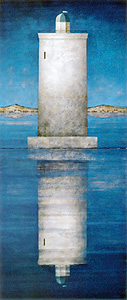 nd Pythagorean numbers, balance and harmony. The painter knows that today there is more philosophy and traces of the great mind in old architecture than in books of contemporary blabbermouths or schizophrenic postmodern discourse. Exactly because of this, her paintings do not contain narration but pure visual art, there is no city either, only traces of it, only individual edifices, palaces and fortresses that she is focused on. She is not interested in urbanism, just like she is not a realist who is giving her blessings to, extolling or illustrating her subject matter. She is an abstract painter in the way in which abstraction really exists – on a higher, angelic level of balance, symbol and miracle. nd Pythagorean numbers, balance and harmony. The painter knows that today there is more philosophy and traces of the great mind in old architecture than in books of contemporary blabbermouths or schizophrenic postmodern discourse. Exactly because of this, her paintings do not contain narration but pure visual art, there is no city either, only traces of it, only individual edifices, palaces and fortresses that she is focused on. She is not interested in urbanism, just like she is not a realist who is giving her blessings to, extolling or illustrating her subject matter. She is an abstract painter in the way in which abstraction really exists – on a higher, angelic level of balance, symbol and miracle.
That is why this artist has managed not only to distinguish herself in contemporary production and to become an heir of the architectural painting tradition, but to become one of the last in a series of painters of the ideal city. And this is the field of activity of painters, visionaries, mathematicians and garden builders. In her paintings, she has saved a part of the heritage, probably the most mysterious one, about which we know less than about the fantasy of Bomarzo Garden, giving the new meaning to canvas painting. More than that, she has revalued the local and the national, and placed the typical Italian into a wider, international context, where it has gained new meanings. Ana Kapor is a traditionalist in the real sense of the word, and so her art symbolizes a constant, live and always new submission of the original.
***
Crystalline structure
Already on the phenomenal level, Ana Kapor’s Belgrade exhibition this fall was superbly conceived and realized. The placement of artwork, its arrangement into thematic units, similar in format and frames, painting equipment very simple but adequate and aesthetized, logical movement of the observer, were carefully conceptualized and realized. In comparison with numerous local disheveled, sloppy and chaotic exhibitions, this one, in line with the content of her paintings, had crystalline structure.
***
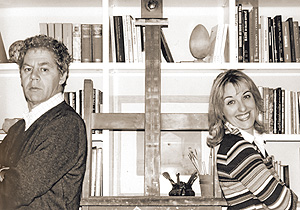 A couple A couple
Early last year, Ana Kapor with her husband exhibited at the well-known museum ”Panorama”, in Bad Frankenhausen, Germany, the key place for the promotion of (among others) Verner Tibke, the most significant German figural painter. The exhibition lasted four months, it featured about one hundred and fifty works collected from various collections around the world and, on this occasion, a monograph was published instead of a catalogue. The success was great.
Ana Kapor and Vladimir Pajević often appear as a painting couple, which is popular in the West and several books have been dedicated to this phenomenon.
|
